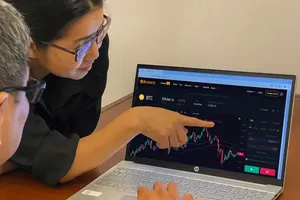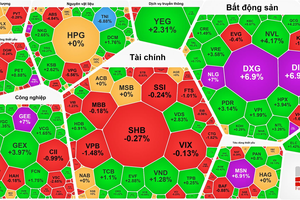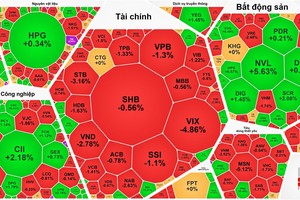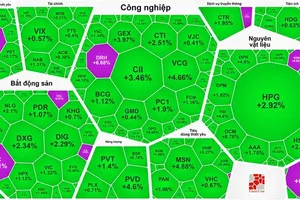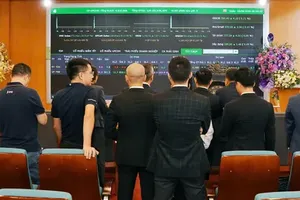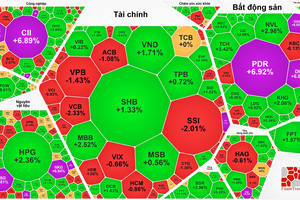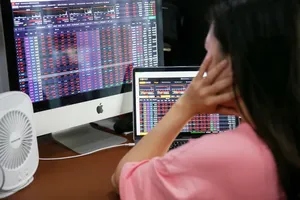Meanwhile, on the Hanoi Stock Exchange (HNX), the HNX-Index made a breakthrough of nearly 3 percent. At the end of the trading session, the VN-Index inched up by 0.34 points, or 0.03 percent, to close at 1,186.95 points, with 270 gainers, 168 losers, and 64 unchanged stocks. The HNX-Index jumped 6.16 points, or 2.48 percent, to 254.1 points, with 137 gainers, 66 losers, and 57 unchanged stocks.
Foreign investors continued to net sell nearly VND500 billion on the whole market. Of which, they net sold VND470 billion on the HoSE. Liquidity remained at a high level with a total trading volume of 819 million shares, worth more than VND18.1 trillion. Of which, put-through transactions accounted for nearly VND1.77 trillion.
The stock market traded with caution from investors after the new General Director of the HoSE Le Hai Tra spoke in the media about a solution to prevent network congestion, which possibly is to raise the minimum round lot from 100 shares to 1,000 shares to reduce the load for the trading system.
According to the HoSE’s calculations, increasing the round lot to 1,000 shares can reduce the total number of trading orders by 40-50 percent, at the same time, it can pave the way for new heights of market liquidity.
Mr. Tra said that that might only be a temporary solution to solve the current network congestion situation. In the future, when the new stock trading system comes into operation, there will be an odd-lot board, and it is also possible to return to the current round lot of 100 units. However, this opinion faced considerable opposition from investors because it will make it difficult for investors, especially small investors. Because they will have to spend 10 times as much as currently to buy stocks on the HoSE.
Another solution to prevent network congestion for the HoSE is to transfer some stocks from the HoSE to the HNX, the State Securities Commission (SSC) has just sent documents to the HoSE, the HNX, and the Vietnam Securities Depository (VSD) on this.
Accordingly, the SSC requested the HNX to promptly accept and receive listed companies from the HoSE, without reviewing their records following the new listing process. The transaction mechanisms, transaction supervision, listing management, reporting, and information disclosure will be applied the same as companies listed on the HNX. The HoSE and the HNX will cooperate in supervising transactions for these stocks to ensure continuity of supervision.
Noticeably, the SSC stated clearly that shares of transferred companies, which are currently in the set of the VN-Index indicators of the HoSE will be removed from the set of HoSE indicators during the temporary transfer to the HNX. At present, SSC will temporarily not consider transferring the shares of companies currently in the VN30-Index.
The SSC also requested the HNX, the HoSE, and the VSD to urgently handle the issue so that enterprises can transfer the transactions of their shares similarly to the listing transfer cases that have been carried out so far. This mechanism will be applied from March 3 this year.
Foreign investors continued to net sell nearly VND500 billion on the whole market. Of which, they net sold VND470 billion on the HoSE. Liquidity remained at a high level with a total trading volume of 819 million shares, worth more than VND18.1 trillion. Of which, put-through transactions accounted for nearly VND1.77 trillion.
The stock market traded with caution from investors after the new General Director of the HoSE Le Hai Tra spoke in the media about a solution to prevent network congestion, which possibly is to raise the minimum round lot from 100 shares to 1,000 shares to reduce the load for the trading system.
According to the HoSE’s calculations, increasing the round lot to 1,000 shares can reduce the total number of trading orders by 40-50 percent, at the same time, it can pave the way for new heights of market liquidity.
Mr. Tra said that that might only be a temporary solution to solve the current network congestion situation. In the future, when the new stock trading system comes into operation, there will be an odd-lot board, and it is also possible to return to the current round lot of 100 units. However, this opinion faced considerable opposition from investors because it will make it difficult for investors, especially small investors. Because they will have to spend 10 times as much as currently to buy stocks on the HoSE.
Another solution to prevent network congestion for the HoSE is to transfer some stocks from the HoSE to the HNX, the State Securities Commission (SSC) has just sent documents to the HoSE, the HNX, and the Vietnam Securities Depository (VSD) on this.
Accordingly, the SSC requested the HNX to promptly accept and receive listed companies from the HoSE, without reviewing their records following the new listing process. The transaction mechanisms, transaction supervision, listing management, reporting, and information disclosure will be applied the same as companies listed on the HNX. The HoSE and the HNX will cooperate in supervising transactions for these stocks to ensure continuity of supervision.
Noticeably, the SSC stated clearly that shares of transferred companies, which are currently in the set of the VN-Index indicators of the HoSE will be removed from the set of HoSE indicators during the temporary transfer to the HNX. At present, SSC will temporarily not consider transferring the shares of companies currently in the VN30-Index.
The SSC also requested the HNX, the HoSE, and the VSD to urgently handle the issue so that enterprises can transfer the transactions of their shares similarly to the listing transfer cases that have been carried out so far. This mechanism will be applied from March 3 this year.


